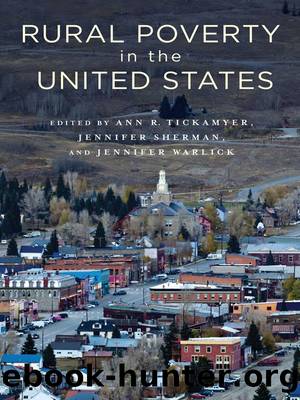Rural Poverty in the United States by unknow

Author:unknow
Language: eng
Format: epub
Tags: Rural, Development, Social Science, Poverty & Homelessness, Social Science/Sociology/Rural, Economic Development, Social Science/Poverty & Homelessness, sociology, SOC026020, Business & Economics, SOC045000
ISBN: 9780231544719
Google: zKAvDwAAQBAJ
Publisher: Columbia University Press
Published: 2017-08-22T00:26:55.200551+00:00
Figure 9.1 Low-employment counties, 2000.
Source: Economic Research Service, County Policy Types, USDA.
Note: Low-employment counties are those where less than 65 percent of residents 21 to 64 years old were employed in 2000.
Employment typically represents a necessary condition for escaping economic hardship among the poor, but it should not be mistaken as a sufficient condition for doing so. In what follows, an original descriptive analysis is provided that compares employment hardship among rural and urban workers from 2002 to 2012, drawing on data from the countryâs most comprehensive annual national labor force survey, the March Current Population Survey (CPS). Linked annual data files from the March CPS were analyzed over this period to examine the employment circumstances of individuals aged eighteen to sixty-four years (i.e., those of working age).2 This approach extends analysis presented in Slack (2014) by carrying the record forward through the Great Recession and the very slow economic recovery that followed.
The focus of this volume is on poverty, but the official poverty measure used by the U.S. federal government has well-documented limitations (Citro and Michel 1995). Due to this chapterâs focus on labor markets, the analysis pivots from the consideration of economic hardship as measured by poverty (i.e., having a very low income) to examine underemployment, which captures broader forms of disadvantage. The concept of underemployment encourages us to think about different types of hardship that workers face as they endeavor to make a living in the labor market. Although measures of both poverty and underemployment capture ways people are struggling economically, they are not synonymous. Not only are different types of information used to develop each measure, but the populations of people assessed by each differs as well. Poverty is determined for nearly all members of the civilian population, whereas underemployment focuses on adults in the labor force (i.e., those of working-age who are either employed or actively looking for work).3 Therefore, it is possible to be underemployed but not be a member of a poor family or to be a member of a poor family but not be underemployed. The measurement of underemployment is detailed further in the following discussion, but the larger point is simply that it is necessary to think about the multidimensional types of hardship workers face in the American labor market.
Using the Labor Utilization Framework (LUF) developed by Clogg and Sullivan (Clogg 1979; Clogg and Sullivan 1983; Sullivan 1978), the operational states of underemployment examined here are:
Download
This site does not store any files on its server. We only index and link to content provided by other sites. Please contact the content providers to delete copyright contents if any and email us, we'll remove relevant links or contents immediately.
Kathy Andrews Collection by Kathy Andrews(11730)
The remains of the day by Kazuo Ishiguro(8823)
Paper Towns by Green John(5091)
Spare by Prince Harry The Duke of Sussex(5072)
Industrial Automation from Scratch: A hands-on guide to using sensors, actuators, PLCs, HMIs, and SCADA to automate industrial processes by Olushola Akande(4982)
The Body: A Guide for Occupants by Bill Bryson(4974)
Machine Learning at Scale with H2O by Gregory Keys | David Whiting(4183)
Be in a Treehouse by Pete Nelson(3948)
Never by Ken Follett(3791)
Harry Potter and the Goblet Of Fire by J.K. Rowling(3775)
Goodbye Paradise(3728)
Into Thin Air by Jon Krakauer(3313)
The Remains of the Day by Kazuo Ishiguro(3293)
The Cellar by Natasha Preston(3262)
The Genius of Japanese Carpentry by Azby Brown(3224)
Fairy Tale by Stephen King(3220)
120 Days of Sodom by Marquis de Sade(3181)
The Man Who Died Twice by Richard Osman(2997)
Drawing Shortcuts: Developing Quick Drawing Skills Using Today's Technology by Leggitt Jim(2996)
